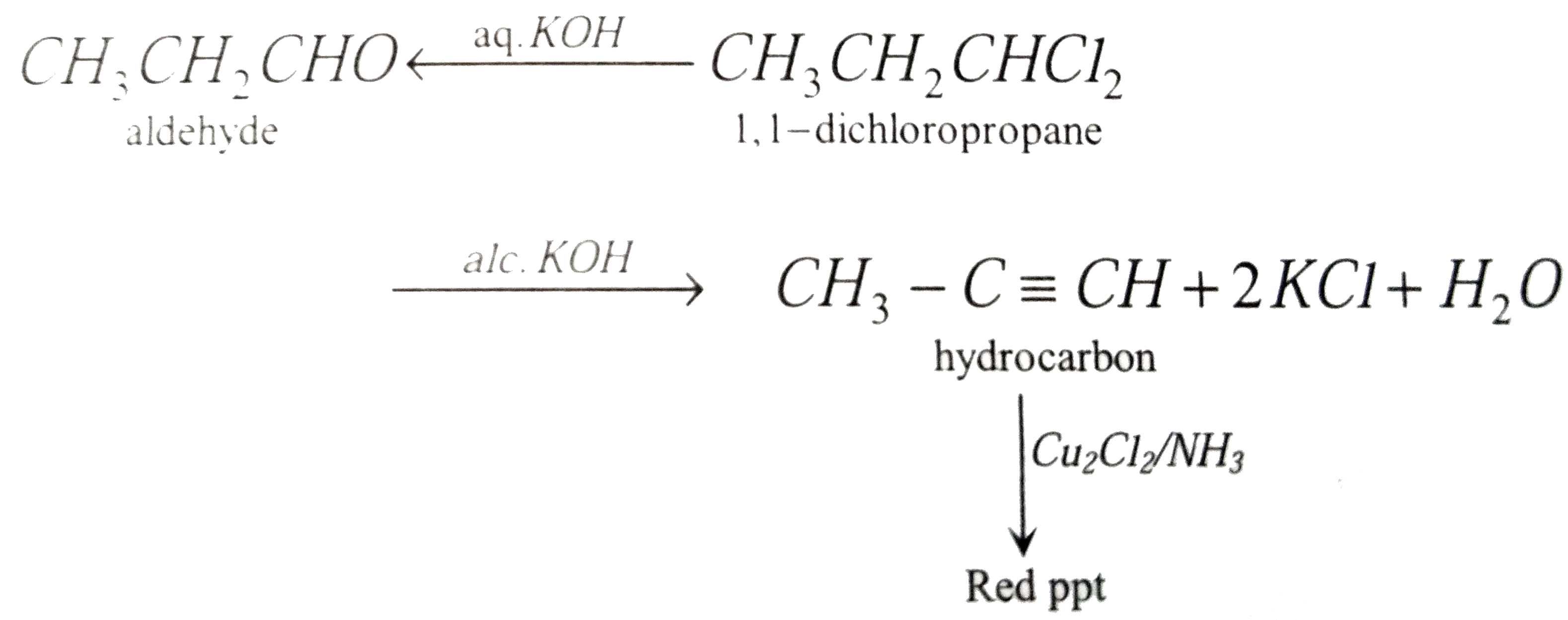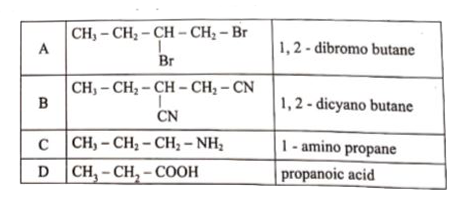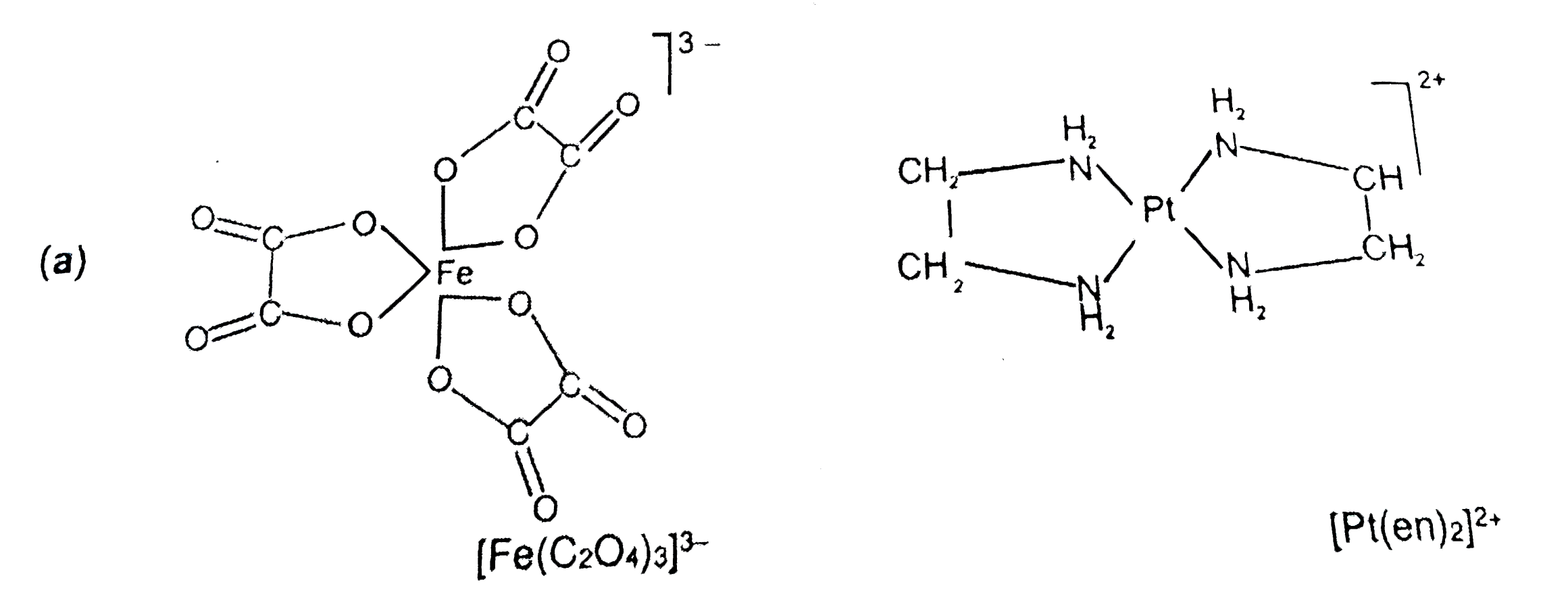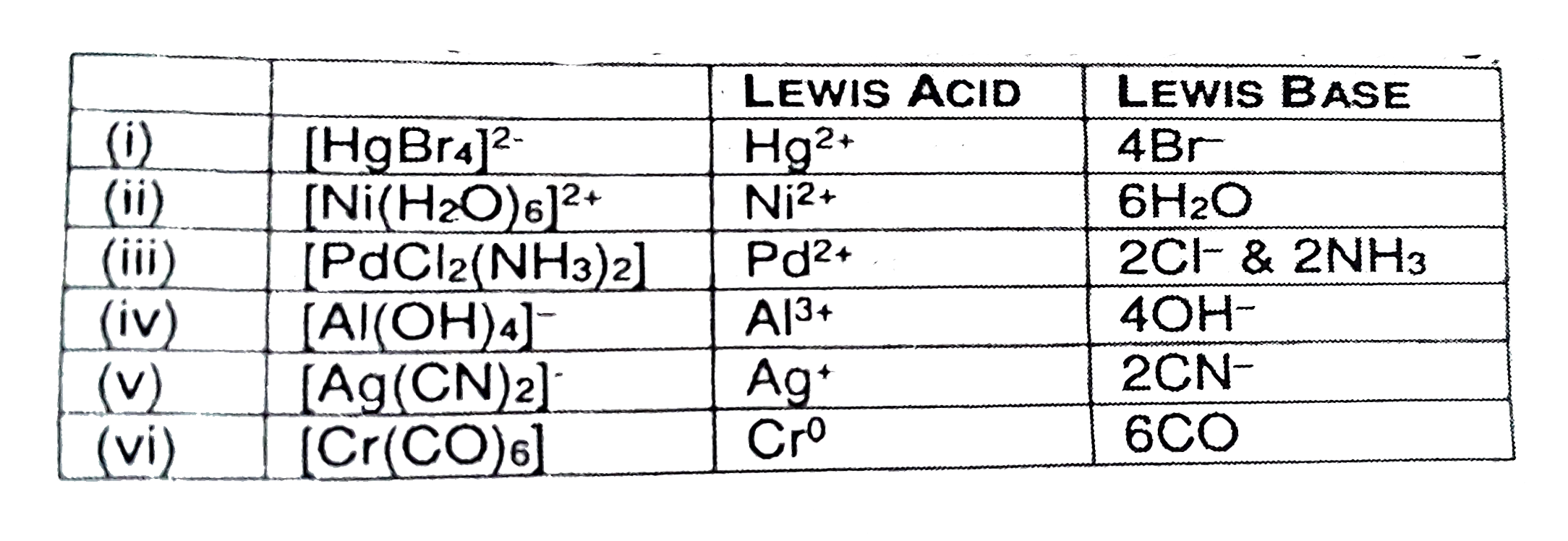InterviewSolution
This section includes InterviewSolutions, each offering curated multiple-choice questions to sharpen your knowledge and support exam preparation. Choose a topic below to get started.
| 89951. |
A dilute solution of a non-volatile solute in water freezes at — 0.2°C. At what temperature (in °C) the same solution will boil? (K_f for H_2O = 1.86°Cm^-1) and K_b for H_2O = 0. 515°C m^(-1)) |
|
Answer» 100.121 |
|
| 89952. |
A dilute solution havingon mole of solute 'S' in 1 kg solvent with molal elevation constant K_(b) Solute undergoes association as follows.2ShArrS_(2)The degree of association of solute alpha is given by the following expression . alpha=(1-i)/(1-1//n) Where, in the number of molecular of solute undergoing association . The degree of associationcan be given as : |
|
Answer» `alpha =(DeltaT_(B))/(2K_(b))` |
|
| 89953. |
A dilute solution contains m mole of solute A in 1 kg of a solvent with molal elevation constant K_(b). The solute A undergoes dimerization as 2 A hArr A_(2). Show that equilibrium constant for dimer formation is given by: K_(c ) = (K_(b)(K_(b)m-Delta T_(b)))/((2DeltaT_(b)-K_(b)m)^(2) where Delta T_(b) is elevation in boiling point for given solution. Assume molarity = molality. |
| Answer» | |
| 89954. |
A dilute solution contains m mol of solute A in 1 kg of a solvent with molal elevation constant K_(b). The solute dimerises in solution as 2AhArrA_(2) Select the correct exprression of equilibrium constant 'K' for the dimer formation. (assume molarity = molality) |
|
Answer» `K=(K_(b)(K_(b)m-DeltaT_(b)))/((K_(b)m+2DeltaT_(b))^(2))` moles at `t=0, m, 0` moles at `t_(eq), m-malpha, (malpha)/2` Total moles `=m-(m alpha)/2=m(1-(alpha)/2)` `DeltaT_(b)=iK_(b)m=K_(b)m(1-(alpha)/2)` `1-(alpha)/2=(DeltaT_(b))/(K_(b)m)` `alpha=(2(K_(b)m-DeltaT_(b)))/(K_(b)m)` Equilibrium constant `K` for the dime FORMATION is `K=([A_(2)])/([A]^(2))=(malpha)/(2[m(1-alpha)]^(2))` `K=(alpha)/(2m(1-alpha)^(2))` `K=(2(K_(b)m-DeltaT_(b)))/(K_(b)m)//2m[1-(2(K_(b)m-DeltaT_(b)))/(K_(b)m)]^(2) ` `K=(K_(b)(K_(b)m-DeltaT_(b)))/((K_(b)m-2K_(b)m+2DeltaT_(b))^(2))` `K=(K_(b)(K_(b)m-DeltaT_(b)))/((2DeltaT_(b)-K_(b)m)^(2))` |
|
| 89955. |
A dilute aqueous solution of Li_2SO_4 is electrolysed . The products formed at the anode and cathode, respectively are: |
|
Answer» S and LI |
|
| 89956. |
A dilalogen denvative (X) with three carbon atoms reacts wih alcoholic KOH to give hydrocarbon (Y) which gives a white precipitate with ammonical AgBO_(3) (X). With aqueous KOH it gives a ketone, The compound (X) is |
|
Answer» 2, 2, -dichloropropane |
|
| 89957. |
A dilute aqueous solution of Na_(2)SO_(4) is electrolysed using platinum electrodes. The products at the anode and cathode are |
|
Answer» `O_(2),H_(2)` At CATHODE:`2H_(2)O+2e^(-)toH_(2)+2OH^(-)` At anode: `2H_(2)toO_(2)+4H^(+)+4e^(-)` |
|
| 89958. |
A dihalogen derivative 'X' of hydrocarbon with three carbon atom reacts with alcoholic KOH and produces another hydrocarbon which forms a red precipitate with ammoniacal Cu_(2)Cl_(2). 'X' gives an aldehyde on reaction with aqueous KOH. The compound X is |
|
Answer» 1, 3-Dichloro propane 
|
|
| 89959. |
A dihedral angle HCH in staggered conformation of C_(2)H_(6) is : |
|
Answer» `120^(@)` |
|
| 89960. |
A dihalogen dervative 'X' of a hydrocarbon with three carbon atoms reacts with alcoholic KOH and produces another hydrocarbon whichforms a red precipitate with ammoniacal Cu_(2)Cl_(2).'X' gives an aldehyde on reaction with aqueous KOH. The compound 'X' is : |
|
Answer» 1,3-dichloropropane 
|
|
| 89961. |
(a) Differentiate betweena disinfectantand an antiseptics. Givenone example of each. (ii) Whatis tincture of iodine and whatis it used for ? . |
|
Answer» Solution :(a) Antiseptics are applied to the livingtissue such as floors, drainage systemas woundscuts, ulcers and DISEASED skin surface. Examples are furacine, soframine, etc. Disinfectants are appliedto inanimate objects such as floors,drainage system, INSTRUMENTS etc. samesubstance can act as an antispetic as well as disinfectant byvaryingthe concentration. For EXAMPLE, 0.2 per cent solution of phenol is an antisepticwhileits one pre cent solution is disnfiectant. (b) Iodine is a powerfull antispetic . Its 2-3 per cent solution in alcohol-watermixture is known as tincture of iodine. It is appliedon WOUNDS. Iodoform is also an ANTISEPTIC for wounds. Boric acidin dilute aqueous solutions is weekantispetic for eyes. |
|
| 89962. |
(A) Diethyl ether is used as general anaesthetic (R) Diethyl ether produces unconscio-usness without effecting lungs. |
|
Answer» Both (A) and (R) are true and (R) is the CORRECT explanation of (A) |
|
| 89963. |
A diene, buta - 1, 3 - diene was subjected to ozonolysis to prepare aldehydes. Which of the following aldehydes will be obtained during the reaction ? |
|
Answer» `overset("CHO")underset("CHO")("|") +2HCHO` |
|
| 89964. |
(A) Dichloro carbene acts as electrophile in Reimer-Tiemann reaction.(R) Dichloro carbene has two electrons on carbon atom. |
|
Answer» Both (A) and (R) are TRUE and (R) is the CORRECT EXPLANATION of (A) |
|
| 89965. |
A dibromoderivative of an alkane reacts with sodium metal to form an alicylic hydrocarbon. The derivative is: |
|
Answer» 1,1-dibromopropane  . .
|
|
| 89966. |
A dibromo derivative of an alkane reacts with sodium metal to form an alicyclic hydrocarbon. The derivative is |
|
Answer» 1,1-dibromopropane 
|
|
| 89967. |
A dibromo derivative (A) on treatment with KCN followed by acid hydrolysis and heating gives a monobasic acid (B), along with liberation of CO_(2). (B)on heating with liquid ammonia followed by treating with Br_(2)//KOH gives © which on treating with NaNO_(2) and HCl at low temperature followed by oxidation gives a monobasic acid (D) having molecular mass 74. Identify A to D. |
Answer» Solution :  <BR> (ii) `CH_(3)-UNDERSET((B))underset(("Butanoic acid"))(CH_(2)-CH_(2))-COOH underset(Delta)OVERSET(liq. NH_(3))(to) CH_(3)-underset(("Butanamide"))(CH_(2)-CH_(2)-CONH_(2))overset(Br_(2)//KOH)(to) CH_(3)-underset((C))underset((1-"Aminopropane"))(CH_(2)_CH_(2)-NH_(2))` <BR> (ii) `CH_(3)-UNDERSET((B))underset(("Butanoic acid"))(CH_(2)-CH_(2))-COOH underset(Delta)OVERSET(liq. NH_(3))(to) CH_(3)-underset(("Butanamide"))(CH_(2)-CH_(2)-CONH_(2))overset(Br_(2)//KOH)(to) CH_(3)-underset((C))underset((1-"Aminopropane"))(CH_(2)_CH_(2)-NH_(2))` (iii) `underset((C))underset((1-"Aminoprpane"))(CH_(3)-CH_(2)_CH_(2)-NH_(2)) underset("Low temperature")overset(NaNO_(2)//HCl)(to) underset((1-"PROPANOL"))(CH_(3)-CH_(2)-CH_(2))-OHunderset(2(O))overset(K_(2)Cr_(2)O_(7)//H^(+))(to) underset((D))underset(("Propanoic acid"))(CH_(3)-CH_(2)-COOH)` 
|
|
| 89968. |
A Dibromo derivative (A) on treatment with KCN followed by acid hydrolysis and heating gives a monobasic acid (B) along with liberation of CO_2. (B) on heating with liquid ammonia followed by treating with Br_2"/"KOH gives (C ) which on treating with NaNO_3 and HCl at low temprerature followed by oxidation gives a monobasic acid (D) having molecular mass 74. Identify A to D. |
|
Answer» Solution :(a) `underset(1,2-"dibromubutane")(1,2-CH_(3)-CH_(2)-underset(Br)underset(|)(CH)-underset(Br)underset(|)(CH_(2)) overset(KCN) to underset(1,2-"dicyanobutane")(CH_(3)-underset(CN)underset(|)CH - underset(CN)underset(|)(CH_(2)) overset((i) H^(+)//H_(2)O)underset((II) "Heat") to CO_(2) + underset("Butanoic acid")(CO_(2) + CH_(3) -CH_(2) -CH_(2)-COOH` 2. `underset("Butanoic acid")(CH_(3)-CH_(2)-COOH) overset(liq. NH_(3)) underset(Delta)to underset("Butanamide")(CH_(3)-CH_(2)-CH_(2)-CONH_(2)) overset(Br_(2)//KOH) to underset("1-Aminopropane") (CH_(3)-CH_(2)-CH_(2)-NH_(2))` 3. `underset(1-"Aminopropane")(CH_(3)-CH_(2)-NH_(2)) overset(NaNO_(2)//HCL) underset("Low temperature") to underset(1-"PROPANOL")(CH_(3)-CH_(2) -OH) overset(K_(2)Cr_(2)O_(7)//H^(+))underset(2(0)) to underset("Propanoic acid")(CH_(3)-CH_(2)-COOH)` 4. Molecular mass of propanoic acid is 74 
|
|
| 89969. |
A dibasic anhydrous acid produced upon combustion 0.195g of CO_(2) and 0.04g of H_(2)O. 0.5g of the salt of this acid when ignited, converted to 0.335g of pure silver. Find the molecular formula of the dibasic acid. |
| Answer» SOLUTION :`(COOH)_(2)` | |
| 89970. |
A diazonium salt reacts with phenol to give an azo dye . The reaction is called : |
|
Answer» DIAZOTISATION |
|
| 89971. |
A diazonium salt dissociates according to the equationCH_3C_6H_4N_2Cl + H_2O to CH_3C_6H_4OH + N_2+HCl The dissociation process is a first-order reaction whose rate constants at 297.9 K and 303.2 K are 9 xx 10^(-3)and 13 xx 10^(-3)"min"^(-1)respectively. Calculate the rate constant at 308.2 K and the time for 99% dissociation of the salt at 308.2 K. |
| Answer» Solution :`16.37 XX 10^(-3) "MIN"^(-1) , 282` min | |
| 89972. |
(A) Diatomic sulphur hs a dicovalent bond (R ) General valency of sulphur is two |
|
Answer» Both (A) and (R ) are TRUE and (R ) is the correct explanation of (A) |
|
| 89973. |
A diatomic molecule is stable only when : |
|
Answer» 1. Number of bonding and antibonding molecular orbitals are equal |
|
| 89974. |
Diatomic molecule has a dipole moment of 1.2D If its bond 1.0 Å what fraction of an electronic charge exists on each atom ? . |
|
Answer» |
|
| 89975. |
A diatomic molecule has a dipole moment of 1.2 D. If its bond distance is 1.0 Å, what fraction of an electronic charge, e, exists on each atom? (1 D = 10^(-18) esu cm and e = 4.8 xx 10^(-10) esu) |
|
Answer» |
|
| 89976. |
A diatomic ideal gas is used in a Carnot engine as the working substance. If during the adiabatic expansion part of the cycle the volume of the gas increases from V to 32 V, the efficiency of the engine is - |
|
Answer» 0.25 |
|
| 89977. |
A diatomic ideal gas initiallyat273 K is given100 cal heatdue to whichsystemdid 209 J work. Molar heatcapacity(C_(m))n of gasfor the process is : |
|
Answer» `(3)/(2) R` `C_(m)= (100R)/(20) R` |
|
| 89978. |
A diatomicgaseous species A_(2) (g) decomposes into atomic A by first order kinetics as : A_(2) (g) to 2A (g) An empty flask was filled with A_(2) (g) "and" N_(2) (g) at an initial pressure of 800 mm of Hg at 600 K and sealed After a very long time gases in the flask developed a pressure 1400mm of Hg If half-life for the decomposition process is 2 hr, what was the pressure in the after 4 Hr from start? Assume N_(2) to be an inert gas. [Find your answer in cm of Hg] |
|
Answer» |
|
| 89979. |
(A) Diastereomers are not mirror image of each other. (R) Diastereomers may be optically active. |
|
Answer» |
|
| 89980. |
(A) Diamond and graphite are polymorphic forms (R) Carbon adopts different structural arrangements under different conditions to give these two forms. |
|
Answer» Both (A) and (R) are TRUE and (R) is the CORRECT explanation of (A) |
|
| 89981. |
(A) Diamond and graphite do not have same crystal structure. (R) Diamond is crystalline while graphite is amorphous |
|
Answer» Both (A) and (R) are true and (R) is the correct explanation of (A) |
|
| 89983. |
Explain the diagonal relationship between LIthium and Magnesium |
|
Answer» sodium |
|
| 89984. |
A diabetic person carries a packet of glucose with him always, because |
|
Answer» Glucose increase the BLOOD sugar level slowly |
|
| 89985. |
A dextrorotatory sugar present in fruits is |
|
Answer» GALACTOSE |
|
| 89986. |
A dextrorotatory optically active alkyl halide undergoes hydrolysis by S_N2 mechanism. The resulting alcohol is. |
|
Answer» DEXTROROTATORY |
|
| 89987. |
A developer used in photography is : |
|
Answer» A week acid |
|
| 89988. |
A device used to convert chemical energy into electrical energy is called ______ |
|
Answer» ELECTROLYTIC cell |
|
| 89989. |
A device used for the measurement of radioactivity is |
|
Answer» MASS spectrometer |
|
| 89990. |
A device that converts energy of combustion of fuels like hydrogen and methane, directly into electrical energy is known as |
|
Answer» ELECTROLYTIC cell |
|
| 89991. |
A deutron contains |
|
Answer» A NEUTRON and a positron |
|
| 89992. |
A device in which spontaneous chemical reaction generates electric current. |
|
Answer» GALVANIC cell |
|
| 89993. |
(a) Determine the denticity of the ligands in complexes [Fe(C_(2)O_(4))_(3)]^(3-) and [Pt(en)_(2)]^(2+). What are the coordination number and the oxidation number of the central metal ion ? (b) Designate the coordination entities and counter ions in the coordination compounds. K_(2)[Ni(CN)_(4)],[Cr(en)_(3)]Cl_(3),F_(4)[Fe(CN)_(6)]_(3),[PtCl_(2)(en)_(2)](NO_(3))_(2). ( c) Identify the Lewis acid and Lewis base components of the following complexes. (i)[HgBr_(4)]^(2-)"" (i) [Ni(H_(2)O)_(6)]^(2+)"" (iii) [PdCl_(2)(NH_(3))_(2)] (iv) [Al(OH)_(4)]^(-)""(v) [Ag(CN)_(2)]^(-) "" (vi) [Cr(CO)_(6)] |
Answer» Solution : The ligands, oxalate and ethylenediamine are bidentate as ech ligand has two donor ATOMS. So in 1st case the number of chelate rings (five membered ) are three where as in 2nd case the number of chelate rings (five membered ) are two. The coordination number and oxidation stae of IRON are six and +3 respectively and the coordination number and oxidation state of platinum are four +2 respectively. ( b)`K_(2)[Ni(CN)_(4)]overset(aq)iff2K^(+)(aq)+[Ni(CN)_(4)]^(2-)(aq)` `[CR(en)_(3)]Cl_(3) overset(aq)IFF[Cr(en)_(3)]^(3+)(aq)+3Cl^(-)(aq)` `Fe_(4)[FE(CN)_(6)]_(3) overset(aq)iff4Fe^(3+)(aq)+3[Fe(CN)_(6)]^(4-)(aq)` `[PtCl_(2)(en)_(2)](NO_(3))_(2) overset(aq)iff[PtCl_(2)(en)_(2)]^(2+)(aq)+2(NO_(3))^(-)(aq)` So, `[Ni(CN)_(4)]^(2-),[Cr(en)_(3)]^(3+),3[Fe(CN)_(6)]^(4-) and [PtCl_(2)(en)_(2)]^(2+)` are coordination entities and `K^(+),Cl^(-), Fe^(3+) and NO_(3)^(-)` are counter ions. ( c) Coordination compounds are acid-base adduct. Cations are electron deficient, therefore, are called Lewis acids where as ligands are electrons donor, therefore, are called as Lewis base. 
|
|
| 89996. |
(A): Detergent contanining more branches in the hydrocarbonpart are water polluting. (R) : Bacteria cannot degrade detergent containing highly branched hydro carbon chain. |
|
Answer» Both (A) and (R) are true and (R) is the CORRECT explanation of (A) |
|
| 89997. |
A detergent C_2H_2solution becomes a colloidal sol at a concentration of 10^3 MOn an average10^33colloidal particles are present in 1mn^3What is the average number of ion are contain in one colloidal particle (micelle)? [Given NA=6 diamond ^2 ] |
|
Answer» `6 diamond O^3` `10^2=6 diamond^2` Number of sodium lauryl sulphate PER `m^3 n^1` Number of colloidal particles per`m^3 m^1` Number of molecules per colloidal PARTICLE `=(600)/10^(13) ` |
|
| 89998. |
A detergent [C_12 H_2SO_(4)^(-) Na^(+)] solution becomes a colloidal sol at a conc. of 10^(-3)M on an average 10^13 colloidal particles are present in lmm what is the average no.of ions are contain in one colloidal particle (micelle) no.of ions 6 x 10^x. x is ....... |
|
Answer» No. of Na lauryl sulphat PER MM `= 6 x 10^14` No. of colloidal particles per mm `= 10^13` No. of molecular per calloidal PARTICLE `(6 xx 10^(14))/(10^(13)) = 60`. |
|
| 89999. |
A desiccator of internal volume of 1 litre and containing nitrogen at 1 atm pressure is partially evacuated to a final pressure of 7.6 mm Hg while the temperature remains constant. What is the volume of the gas at this stage ? |
|
Answer» |
|
| 90000. |
(a) Describe the preparation of acetic acid from acetylene. How can the following be obtained from acetic acd ? (i) Acetone (ii) Acetaldehyde (b) In what way can acetic acid be distinguished from acetone ? (c) Why does carboxylic acid not give the characteristic reactions of a carbonyl group ? |
|
Answer» (C) because the carbonyl group is involved in conjugation. |
|